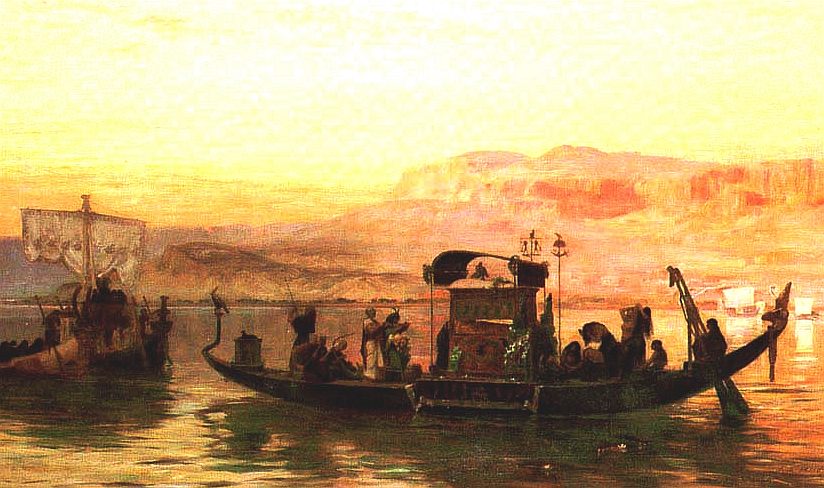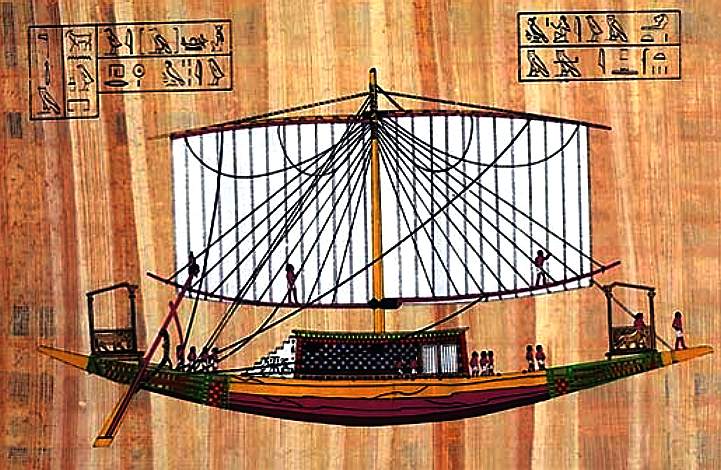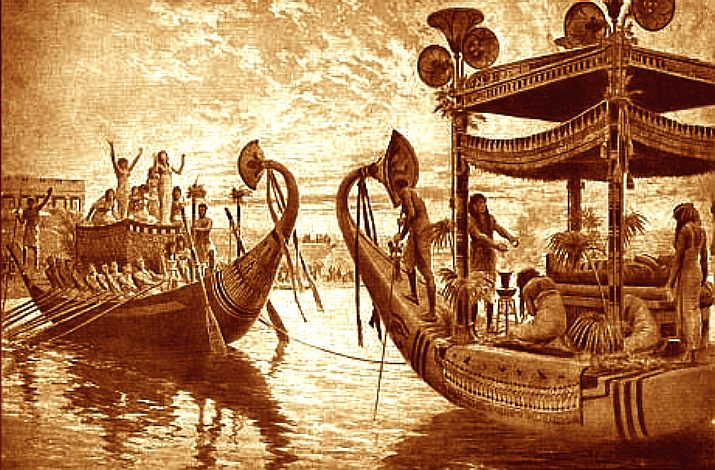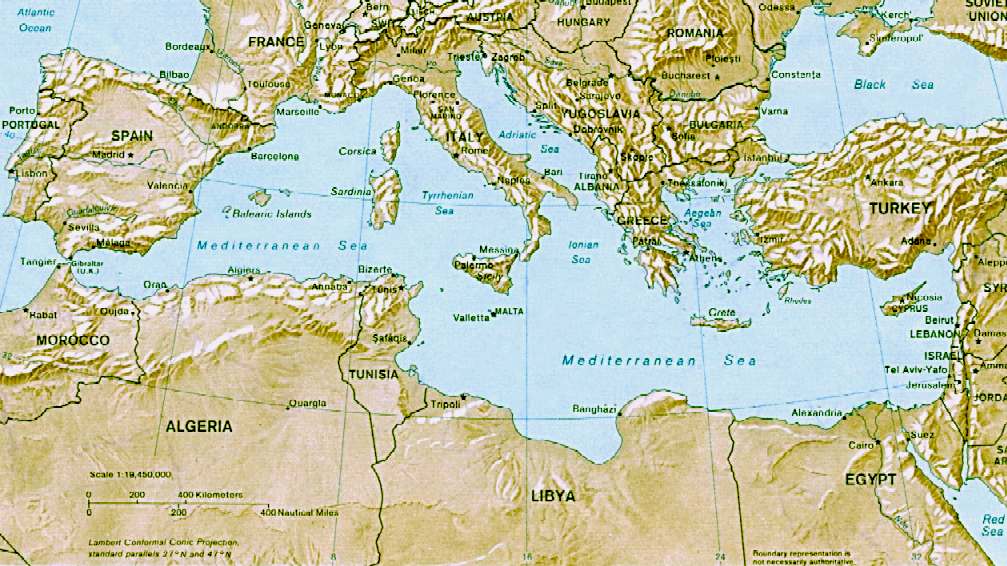
The
Mediterranean Sea is awash with sunken treasures. When Alexander
the Great died in Babylon in 323 BC, his companion, Ptolemy I, laid claim to Egypt as his domain. He founded a dynasty that was to rule for three hundred years from Alexandria. Ptolemy II made Alexandria
the center of culture and founded the Alexandria Library and
Museo, the first research center and “think tank.” The Pharos Lighthouse was built, and it was one of the Seven Wonders of the Ancient World. Its beam of light could be seen for thirty miles.
After Alexander the Great conquered Egypt in 332 BC, he established his city
called Alexandro, which became Alexandria.
On an April day in 331 B.C., on his way to an oracle in the Egyptian desert before he set off to subdue Persia, Alexander envisioned a metropolis linking Greece and Egypt. Avoiding the treacherous mouth of the
Nile, with its shifting currents and unstable shoreline, he chose a site 20 miles west of the great
river, on a narrow spit of land between the sea and a lake. He paced out the city limits of his vision: ten miles of walls and a grid pattern of streets, some as wide as 100 feet.
This was his grand design.
For nearly a millennium, Alexandria was the Mediterranean’s bustling center of
trade. Then Alexandria
was washed into the Mediterranean Sea in AD 365.
The English excavator D. G. Hogarth cautioned after a fruitless dig in the
1890s: “There is nothing to hope for at
Alexandria.” “You classical archaeologists, who have found so much in Greece or in Asia Minor, forget this city.”
French archaeologist Jean-Yves Empereur points out Corinthian capitals, Egyptian lotus-shaped columns and solid Roman bases holding up elegant stone arches. He picks his way across the planks in this ancient cistern, which is three stories deep and so elaborately constructed that it seems more like a cathedral than a water supply system. The cistern was built more than a thousand years ago with pieces of already-ancient temples and churches.
“We supposed old Alexandria was destroyed,” Empereur says, his voice bouncing off the damp smooth walls, “only to realize that when you walk on the sidewalks, it is just below your feet.”
The forgotten cisterns of Alexandria were in particular danger of being filled in by new construction. During ancient times, a canal from the Nile diverted floodwater from the great
river to fill a network of hundreds, if not thousands, of underground chambers, which were expanded, rebuilt and renovated. Most were built after the fourth century, and their engineers made liberal use of the magnificent stone columns and blocks from aboveground ruins.
Few cities in the ancient or medieval world could boast of such a sophisticated water system. “Underneath the streets and houses, the whole city is hollow,” reported Flemish traveler Guillebert de Lannoy in 1422. The granite-and-marble Alexandria that the poets thought long gone still survives.
It was a calm spring day when Empereur and cinematographer Asma el-Bakri, carrying a bulky 35-millimeter camera, slipped beneath the waters near the fort, which had been seldom explored because the military had put the area off limits. Empereur was stunned as he swam amid hundreds of building stones and shapes that looked like statues and columns. The sight, he recalls, made him dizzy.
But after coming out of the water, he and el-Bakri watched in horror as a barge crane lowered 20-ton concrete blocks into the waters just off Qait Bey to reinforce the breakwater near where they had been filming. El-Bakri pestered government officials until they agreed to halt the work, but not before some 3,600 tons of concrete had been unloaded, crushing many artifacts. Thanks to el-Bakri’s intervention,
Empereur - who had experience examining Greek shipwrecks in the Aegean Sea
- found himself back in diving gear, conducting a detailed survey of thousands of relics.
One column had a diameter of 7.5 feet. Corinthian capitals, obelisks and huge stone sphinxes littered the seafloor. Curiously, half a dozen columns carved in the Egyptian style had markings dating back to Ramses II, nearly a millennium before Alexandria was founded. The Greek rulers who built Alexandria had taken ancient Egyptian monuments from along the Nile to provide gravitas for their nouveau riche city. Empereur and his team also found a colossal statue, obviously of a pharaoh, similar to one the Egyptian Navy had raised in 1961. He believes the pair represent Ptolemy I and his wife, Berenice I, presiding over a nominally Greek city. With their bases, the statues would have stood 40 feet tall.
Over the years, Empereur and his co-workers have photographed, mapped and cataloged more than 3,300 surviving pieces on the seafloor, including many columns, 30 sphinxes and five obelisks. He estimates that another 2,000 objects still need cataloging. Most will remain safely underwater, Egyptian officials say.
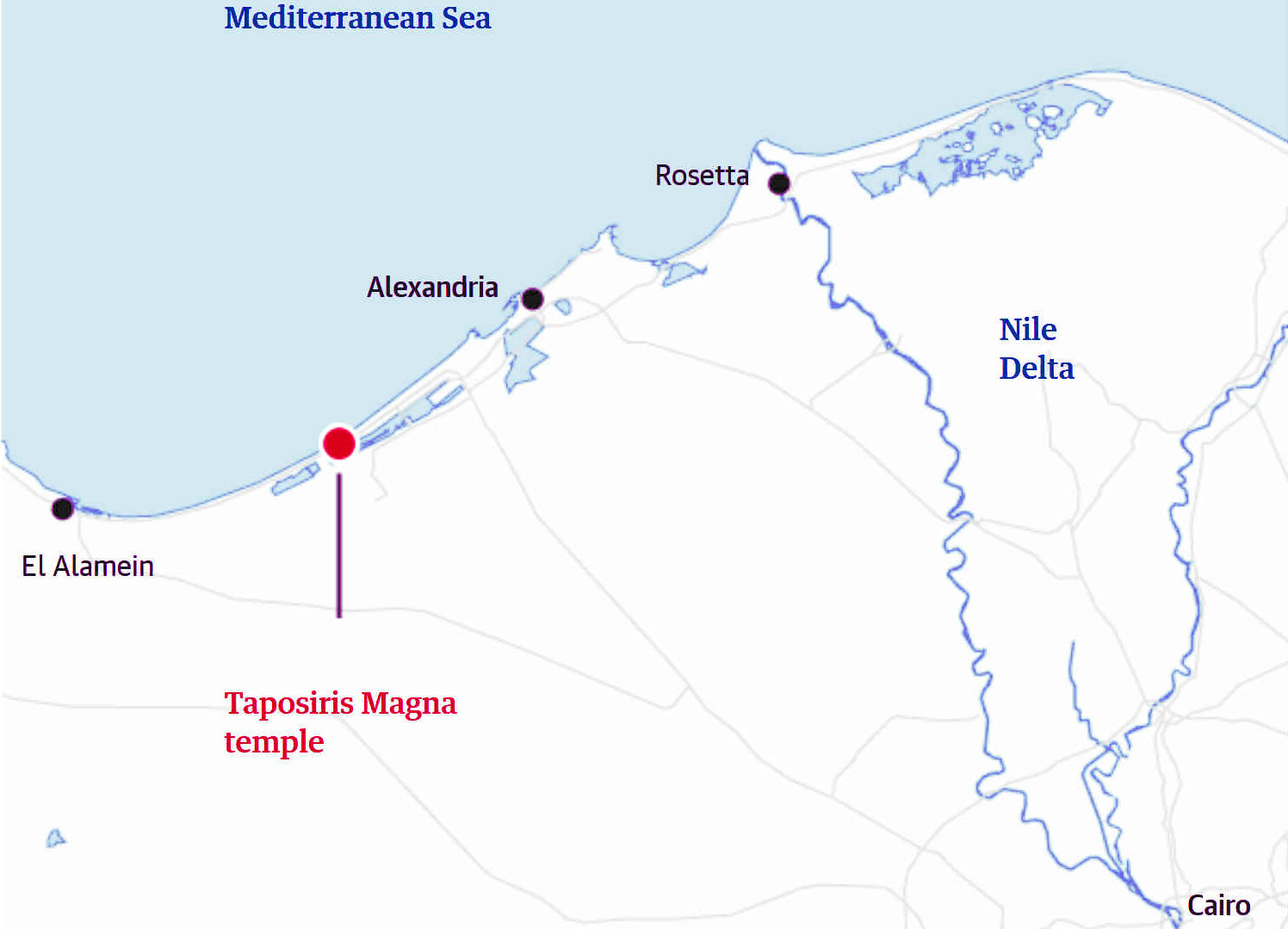
The search for
Cleopatra's elusive tomb, has been at various locations
along the Egyptian coast, including Taposiris Magna.
UNDERWATER PALACES
Franck Goddio is an urbane diver who travels the world examining shipwrecks, from a French slave ship to a Spanish galleon. He and Empereur are
rivals - there are rumors of legal disputes between them and neither man will discuss the
other - and in the early 1990s Goddio began to work on the other side of Alexandria’s harbor, opposite the fortress. He discovered columns, statues, sphinxes and ceramics associated with the Ptolemies’ royal
quarter - possibly even the palace of Cleopatra herself. In 2008, Goddio and his team located the remains of a monumental structure, 328 feet long and 230 feet wide, as well as a finger from a bronze statue that Goddio estimates would have stood 13 feet tall.
Perhaps most significant, he has found that much of ancient Alexandria sank beneath the waves and remains remarkably intact. Using sophisticated sonar instruments and global positioning equipment, and working with scuba divers, Goddio has discerned the outline of the old port’s shoreline. The new maps reveal foundations of wharves, storehouses and temples as well as the royal palaces that formed the core of the city, now buried under Alexandrian sand. Radiocarbon dating of wooden planks and other excavated material shows evidence of human activity from the fourth century B.C. to the fourth century A.D. At a recent meeting of scholars at Oxford University, the detailed topographical map Goddio projected of the harbor floor drew gasps. “A ghost from the past is being brought back to life,” he proclaimed.
But how had the city sunk? Working with Goddio, geologist Jean-Daniel Stanley of the Smithsonian Institution’s National Museum of Natural History examined dozens of drilled cores of sediment from the harbor depths. He determined that the edge of the ancient city had slid into the sea over the course of centuries because of a deadly combination of earthquakes, a tsunami and slow subsidence.
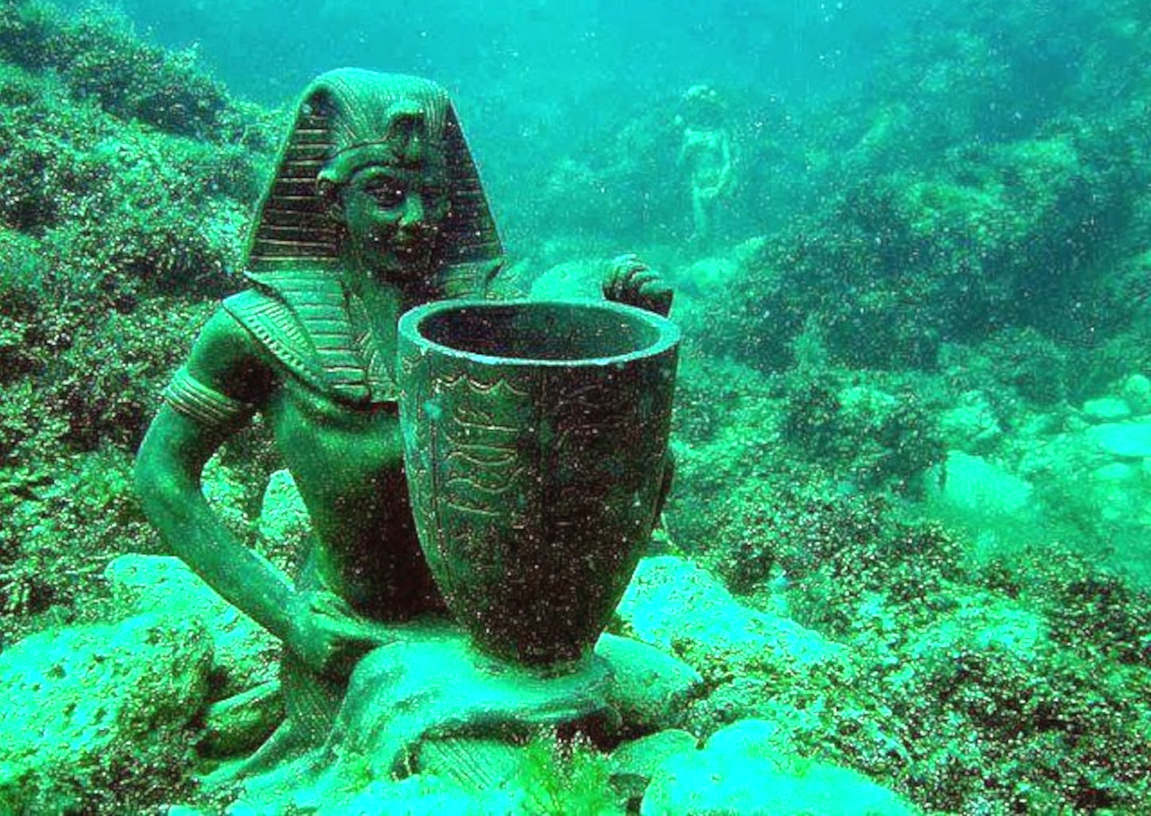
On August 21, in A.D. 365, the sea suddenly drained out of the harbor, ships keeled over, fish flopped in the sand. Townspeople wandered into the weirdly emptied space. Then, a massive tsunami surged into the city, flinging water and ships over the tops of Alexandria’s houses, according to a contemporaneous description by Ammianus Marcellinus based on eyewitness accounts. That disaster, which may have killed 50,000 people in Alexandria alone, ushered in a two-century period of seismic activity and rising sea levels that radically altered the Egyptian coastline.
Ongoing investigation of sediment cores, conducted by Stanley and his colleagues, has shed new light on the chronology of human settlement here. “We’re finding,” he says, “that at some point, back to 3,000 years ago, there is no question that this area was occupied.”
In 1798 after Napoleon landed in Egypt, he conducted a survey of the architecture of the city of Alexandria and
Taposiris
Magna, missing all of the above.
In
2019, excavations were underway to try and discover the tomb
of Cleopatra, with Kathleen
Martinez and Zahi
Hawass, working on digs at Taposiris Magna, with Dr Glenn
Godenho. This led to the discovery of many royal
mummies, a valuable mapping of ancient Egypt, but not the
great Queen herself.

AUGUST
2020
Nearly a dozen scholars with expertise in Cleopatra told Live Science that it’s unlikely that Cleopatra was buried at Taposiris Magna. They also generally agreed that the odds of finding her tomb are slim. Many of the scholars believe that Cleopatra would have been buried within Alexandria, possibly in an area that is now
underwater.
Over the past 2 millennia, coastal erosion has meant that parts of Alexandria, including a section that holds Cleopatra’s palace, are now underwater. Even if the tomb is not underwater, there is a good chance that it was destroyed at some point in antiquity or that it is buried beneath modern-day development in Alexandria, scholars said. There is also a good chance that it was robbed in ancient times, a number of scholars added. At present no projects are searching for Cleopatra’s tomb underwater although past projects have looked at Cleopatra’s palace. Cleopatra was the last of the “Ptolemies,” a line of rulers descended from Ptolemy Soter, one of Alexander the great generals. Alexander, though he died Babylon, was eventually reburied in Alexandria. Ancient writers often mention Alexander’s tomb, but archaeologists have never found it or the tombs of any of the
Ptolemaic rulers.
Cleopatra VII was born in Egypt, but she was descended from a lineage of Greek kings and queens who had ruled Egypt for nearly 300 years. The Ptolemies of Macedonia are one of history’s most flamboyant dynasties, famous not only for wealth and wisdom but also for bloody rivalries and the sort of “family values” that modern-day exponents of the phrase would surely disavow, seeing as they included incest and fratricide.
The Ptolemies came to power after the conquest of Egypt by Alexander the Great, who in a caffeinated burst of activity beginning in 332 B.C. swept through Lower Egypt, displaced the hated Persian occupiers, and was hailed by the Egyptians as a divine liberator. He was recognized as pharaoh in the capital, Memphis. Along a strip of land between the Mediterranean and Lake Mareotis he laid out a blueprint for Alexandria, which would serve as Egypt’s capital for nearly a thousand years.
By the time Cleopatra VII ascended the throne in 51 B.C. at age 18, the Ptolemaic empire was crumbling. The lands of Cyprus, Cyrene (eastern Libya), and parts of Syria had been lost; Roman troops were soon to be garrisoned in Alexandria itself. Still, despite drought and famine and the eventual outbreak of civil war, Alexandria was a glittering city compared to provincial Rome.
Cleopatra was intent on reviving her empire, not by thwarting the growing power of the Romans but by making herself useful to them, supplying them with ships and grain, and sealing her alliance with the Roman general Julius Caesar with a son, Caesarion. It was Cleopatra’s intense identification with Isis, and her royal role as the manifestation of the great goddess of motherhood, fertility, and magic, that ultimately led
Kathleen Martinez to Taposiris Magna. Using Strabo’s ancient descriptions of Egypt, Martinez sketched a map of candidate burial sites, zeroing in on 21 places associated with the legend of
Isis and
Osiris and visiting each one she could find.




